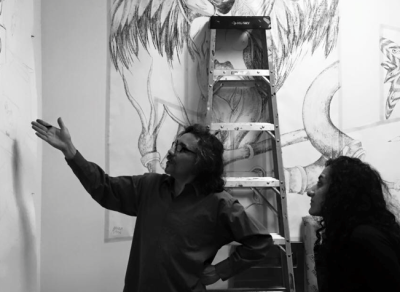Puberty: An interview with Caleb Duarte and Mia Eve Rollow, who take on the position of one of the Poppy’s newest debuts.
The Red Poppy Art House has transformed. Yes, the inside of the physical space looks quite different, with what was known as “the coffin”- founder Todd Thomas Brown’s old peekaboo bed/the Poppy’s corner table – was traded for an ADA accessible entryway. But that is not the only transformation the Red Poppy has taken on this year. The directorial position at the Poppy has also transformed.
Now, the position of Artistic Director will be filled on a rotational basis every four months. This shift in organizational structure is meant to keep the art house fresh and full of new, flowing ideas while also empowering the Artistic Director to explore and hone leadership skills in one of San Francisco’s most creative and adaptive spaces.
Artist Adrian Arias and philosopher Arezoo Haa in the Poppy’s new ADA accessible bathroom.
The first Artistic Director to embody the Red Poppy’s new organizational structure is a pair of artists recently arrived from completing their own independent art-house project in Chiapas, Mexico. Together, Caleb Duarte and Mia Eve Rollow, will be the Artistic Director at the Red Poppy for the next four months. Fearless, and, from their experience in Chiapas, they are ready to release their quietly contained ideas and philosophies on how to engage the community and bring out the artistic essence of all individuals.
Caleb explained, “EDELO,” the name of their creative space in Chiapas, “means where the United Nations used to be. We kept the name to challenge institutions and their role. Creating empathy, creating understanding.” The letters in EDELO are an anagram for En Donde Era La ONU, which translates to “where the United Nations used to be.” In EDELO, artistic types were invited to stay for three to six weeks in the house and create, and all were encouraged to bring the rawness of their creativity into the home. Mia and Caleb understand that the walls of the Poppy are a tad different. One of those differences is that the Poppy’s resident artists don’t live in the space. But still, there are great similarities.
A resident’s room at EDELO
Mia shared that “[EDELO] encapsulates the energy that people bring. Someone can be in the space for a couple hours and the physical space changes, things are moved around…When people leave and new people come, the shape changes a bit.” Mia finds this phenomenon very similar to what she sees take place at the Poppy.
Caleb, added that “the actual space is like a breathing space, it has its own heartbeat, insecurities of its future, its funding. It becomes strong, fragile, weak.”
Now, with the Poppy’s new curatorial direction, it’s in a state much like a “teenager,” said Caleb, who has known the Poppy from its early years.
This stage is shaky, yet exciting…and what’s most exciting is that Caleb and Mia are all about exploring this stage of the Poppy’s life by focusing on something already true to the Poppy’s core: building and sustaining relationships. On their philosophy, Mia said, “with relationship building, things come about– once you get to know people, once you get to hear their stories.”
In Chiapas, Mia revealed, “the doors [were] open all the time and a lot of what [they] did was form relationships with street kids, people on the street, different abled people [and they found] a way to integrate them into the space.”
There was a man who became paralyzed, needed to have his legs amputated, and acquired an infection. He lay in his bed, unable to move and something in his heart shifted: a heart beat– he finally felt alive. For the first time, he felt like he was a worthwhile person. His heart told him “I have value.”
Mia and Caleb worked with this man and his story. An altar was created in which he made legs for himself, stood his body on the legs and then chipped at the plaster of which his legs were constructed until they were destroyed.
Bartolome Martinez in Oaxaca, creating platform legs for himself out of plaster.
“Installations can be confrontational,” Mia admits. But it is this sense of confrontation that Caleb and Mia want to use to bring about each individual’s creative essence-their survival instinct. The big question, according to Caleb is “how do we turn this creativity to cause social change?”
Mostly quiet about their big ideas, Caleb and Mia did let me in on an upcoming project they will implement in the Poppy- a figure drawing class. “The very act of following the line with your eye invites you to a different realm of looking at the world,” says Caleb.
At its twelve years, the Poppy is a preteen taking on a transformation while still maintaining its value of presenting socially conscious arts. With Caleb and Mia as a new directorial duo debuting in a wheel of rotational Artistic Directors, the Poppy begins a growth spurt.
-Red Poppy Art House Writer, Aleksandra Bril



